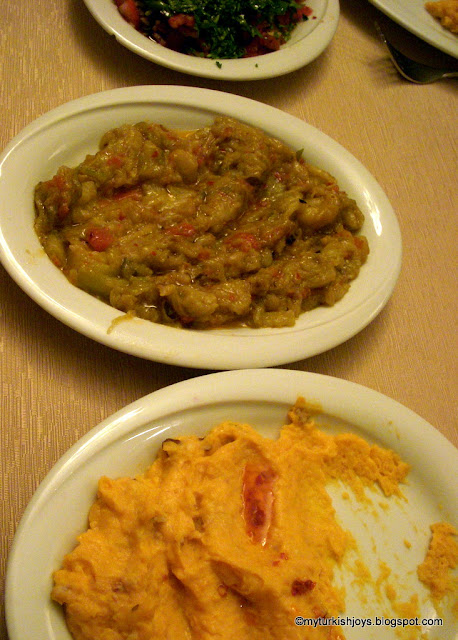When my husband’s friends “joked” that beer was dinner, I was not amused.
This theory may have worked in our 20s, but not now. I had every intention to eat some good food and plenty of pork while I was in London. I wanted to experience the much talked about and read out English gastropub.
So, we started the evening with pints of English ales at Pitcher and Piano in The City. I was a bit disappointed as I was hoping for something more rustic with crumbling brick-lined walls and an ancient history. This shiny-as-a-new-copper-penny pub was packed with men wearing suits (including my husband and his friends since they worked nearby during the day). I think there were 10 other women in the pub beside myself, one of the guys’ girlfriends, and of course, the young, scantily-clad shot girls walking around.
The beer was cold and tasty. I know I tried an English cider and an IPA, but otherwise I don’t recall the names. I just drank what the guys placed in front of me.
This theory may have worked in our 20s, but not now. I had every intention to eat some good food and plenty of pork while I was in London. I wanted to experience the much talked about and read out English gastropub.
So, we started the evening with pints of English ales at Pitcher and Piano in The City. I was a bit disappointed as I was hoping for something more rustic with crumbling brick-lined walls and an ancient history. This shiny-as-a-new-copper-penny pub was packed with men wearing suits (including my husband and his friends since they worked nearby during the day). I think there were 10 other women in the pub beside myself, one of the guys’ girlfriends, and of course, the young, scantily-clad shot girls walking around.
The beer was cold and tasty. I know I tried an English cider and an IPA, but otherwise I don’t recall the names. I just drank what the guys placed in front of me.
The evening was fun. I constantly was amused by the accents of Jason’s friends - both English and Scottish. As the evening wore on, sometimes I just had to sit there and ponder what they said for a moment. The more you drink the funnier the U.K. English language sounds.
A little after 9 p.m., I convinced everyone that yes, I must eat - NOW! As Jason knows, I transform into a Jekyll and Hyde personality when I’m hungry. We piled into two taxis and headed to nearby The Princess of Shoreditch, which I had chosen based on online reviews, its location and its menu.
This gastropub features a very hearty, meat-eccentric menu. I had reviewed the menu several times and couldn’t wait to eat things that I normally don’t get to eat anymore - foie gras, duck and pork. I immediately ordered 7 items off the menu and just asked the server to bring them to the table. The kitchen was closing soon and I wasn’t wasting any time.
The pub was dark and lively, so my pictures didn’t turn out the greatest, but I tried. I also realized it’s hard to make a large pile of meat, covered in dark reductions, look good. Trust me, overall, the food was delicious! Exactly the kind of food you want to have after drinking a few pints.
For starters, I ordered the venison & foie gras terrine, Madeira jelly, port reduction with slices of toasted sour dough, and the smoked salmon plate with Scotch quail’s eggs, chive and crème fraîche dressing. The Scotch egg was interesting - basically a hard-boiled quail’s egg, covered in breadcrumbs and fried.
 |
| The plating of the smoked salmon platter was a bit messy. |
My favorite entree was the chef’s speciality sausage of the day (that day was venison) with chive mashed potatoes, a red onion jam and red wine jus.
The other entrees were good, just not very memorable. There was a confit duck leg with mashed celeriac and a lentil cassoulet.
The braised pigs' cheeks with mashed swede (an English root vegetable) and cider jus needed to be braised a bit longer. Generally, pig or veal cheeks should be fork tender; these were not.
The 28-day air-hung Speyside steak was a bit gristly but was served with red wine jus and hand cut chips on the side.
I have no idea what flavor the "pie" of the day was, but the menu said it was served with fine beans wrapped in bacon and parsley mashed potatoes.
My ah-ha moment came during dessert! I almost didn't share it with anyone. I wanted it all to myself. This simple English dessert, sticky toffee pudding, was warm and snuggly - like sitting next to blazing fire, wrapped up in a blanket and sipping rich, homemade hot cocoa. It was that good! I might have used some other descriptions at the pub, but I won't repeat them now.
 |
| This warm sticky toffee pudding was served with a buttery caramel sauce and vanilla ice cream. |
Cheers!
Pitcher and Piano, 28-31 Cornhill, London, EC3V 3ND
The Princess of Shoreditch, 76 Paul St., London EC2A 4NE
Pitcher and Piano, 28-31 Cornhill, London, EC3V 3ND
The Princess of Shoreditch, 76 Paul St., London EC2A 4NE













































